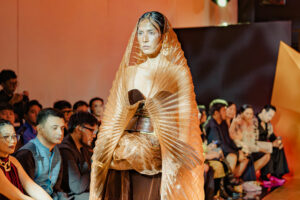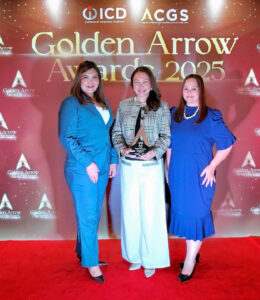
A tale of two fashion weeks
THE CITY was treated to two back-to-back fashion spectacles this month: first came industry stalwart Philippine Fashion Week on Oct. 15, then BYS Fashion Week, now rebranded as Manila Fashion Week (its first showing with that name) just the day after.
Philippine Fashion Week had a one-day showing at the Ayala Museum, featuring designers Jaggy Glarino, Ram Silva, and Jerome Salaya Ang, and a collaboration with chocolate brand Toblerone. Manila Fashion Week, meanwhile, had a four-day showing (from Oct. 16 to 19) at several venues within SM Aura Premier with designers Andrea Tetangco, Don’t Blame The Kids (DBTK), Chris Nick, Viña Romero, OXGN, Íñigo, Randolf, and Viktor.
PHILIPPINE FASHION WEEKThe Oct. 15 Ayala Museum show featured a heist theme, promoting Toblerone’s new product, diamond-shaped Toblerone Truffles. It’s no surprise then that some of the clothes reminded one of chocolate: for example, Mr. Ang opened his show with a model in a rich brown velvet dress with a sweetheart neckline, all veiled in gold. There was a pleated brown dress draped gracefully over the bust, with a matching pleated cape (in an interview, he talked about mimicking the effect of melting chocolate).
We saw a sequined bra with a skirt, crystals, and hooks holding the dress at the hips, followed by a more meditative burgundy gown that reminded one of a monk’s habit. Another dress had black pleats forming a fichu, curving around the shoulders of a model like an ammonite.
Mr. Silva showed red and black dresses: the first one was impressively morose, with a black long-sleeved gown, with a high neck and a floor-length straight skirt, with a windblown cloud of tulle forming a veil. The red dresses, meanwhile, appeared like mirror images of their black counterparts, but with modifications (the red partner would be off-shoulder, or something else).
Mr. Glarino, meanwhile, showed sexy and cozy, utilizing chocolate-brown wool, such as in a dress with a golden ribbon running across the body (with the models holding boxes of Toblerone). Other brown outfits came out, such as a vest and baggy pants on a male model, and a sienna suit with a gold-beaded tank underneath it. There was little else to say, except a commendation for Mr. Glarino’s construction, evident in details like the boning on gowns.
Finally, models came out wearing the Toblerone truffles attached to jewelry to end the show (along with a kitschy skit showing a male model “security guard” eating a truffle to show he had stolen them).
MANILA FASHION WEEKDue to scheduling conflicts, we only managed to attend one show of that season, Randolf, by designer Randolph Santos, on Oct. 19.
At a just-erected tent at SM Aura’s rooftop, a broken heart executed in velvet served as the backdrop for the show. “I wanted to explore the feeling of obsession: a one-way love; eventually losing yourself in the process. But I also wanted to end it on a positive note by realizing your self-worth,” he said in an interview backstage after the show.
Cupid’s arrows made several appearances on the runway, including in a bralette in green tulle, so richly done it looked like grass. The designer’s particular brand of irreverence was seen on the runway, including in tracksuits in iridescent teal and pink, featuring the messy embroidery he’s been known for. A girlish tutu was spread all over with creepy crawlers, and there was a short suit with cartoonish patterns, as well as a royal blue ribbed sweater with a huge tear in the shape of a heart.
Royal blue made an appearance in a parody of Pia Wurtzbach’s winning gown, with torn pageant sashes scattered all over it, and a giant version of one draped as a cape, embroidered with the words “Miss U.” There was a lot of whimsy on the runway, with several opportunities for online virality.
He closed the show with influencer Mimiyuuuh, wearing a trained bubble skirt with heart-shaped darts, with a gartered waist that reminded one of boxing (not boxer) shorts, and a sheer and tight top worn with nothing else underneath.
Mr. Santos did something quite unprecedented for a designer in this city: he came out on the runway with his team. “They were the ones who really made it. It’s their technique. It’s their craft. That’s what I really wanted to highlight in this collection: showcasing the techniques that we’ve built through the years,” he told BusinessWorld.
CHANGESIn an opening speech, executive director and Manila Fashion Week director John Lozano said that the DOST-PTRI (Department of Science and Technology – Philippine Textile Research Institute) supplied some of the textiles for use in the show; Mr. Santos himself used a piña blend in some of his show’s jackets. “Something Filipino doesn’t have to look traditional,” Mr. Lozano told us in an interview. “But if we inject Filipino elements, or at the very least, have it made by Filipinos, then it’s Filipino.”
In another segment of his speech, he said, “There’s really so much division in our country. Everyone seems to want to do their own thing. I don’t know if it’s because we’re an archipelago; we’re (in) islands, and people are just so used to being independent; used to being separated.
“We’re just so wired in such a way that we’re all independent thinkers. Or really, we’re just selfish,” he said. “I choose to believe the former, and not the latter.
“I think tonight’s show… is the perfect closing statement Manila Fashion Week wants to leave to everyone. That at the end of it all, all we really need is love. Love for one another, our country, and for ourselves,” he said. “With love, no one will try to outdo each other, deceive one another, or even steal from one another.”
In an interview, Mr. Lozano talked about the rebrand from BYS Fashion Week (which announced their allegiance to a cosmetics brand) to Manila Fashion Week. “I saw the need for a fashion week that can represent the country. It’s been decades. I’ve been waiting for something like this to happen. When we had the opportunity to do it, we thought, ‘Why not?’”
He also discussed the lineup: “I really wanted to highlight designers that look at themselves as brands,” he said. “Designers who have a unique identity and point-of-view.”
Earlier that week, we talked to Joey Espino, Philippine Fashion Week co-founder, about their lineup: “The past, the present, the future,” he said, without elaborating who was who.
Philippine Fashion Week makes a return on the runway after a hiatus of a few years during and before the pandemic. “We have to make sure that we strike it at the right time, with the right energy for everyone. It’s not just about us organizing. The designers should be ready, and that the market should be ready as well.”
The founders of the two separate fashion weeks talked to us about the back-to-back fashion shows this season.
Mr. Espino said, “We’re happy for them. We used to be very good friends — they’re still our friends. I’ve been telling them that it’s good for the Philippine market, so everything’s getting activated. We have 130 million Filipinos, and we have a lot of Filipino designers and brands as well. This is going to be good for everyone.”
Mr. Lozano said, “I’m happy that there are a lot of fashion weeks. For us, we can only take eight (designers) per season. There’s so much talent in the Philippines. The more people mount their own fashion weeks, the better. There’s more chances for people to show.
“This season, we started inviting international press,” he said, citing media guests from Vietnam, Singapore, and Thailand. “That’s really the goal: for the whole world to see that in the Philippines, in Manila, we have a thriving fashion scene.” — Joseph L. Garcia



